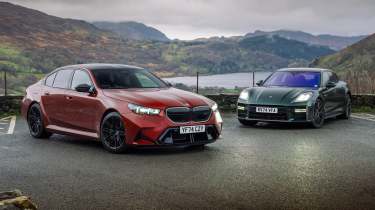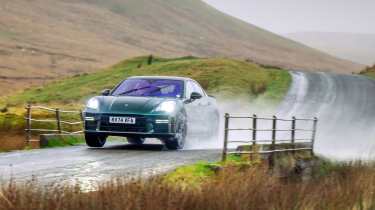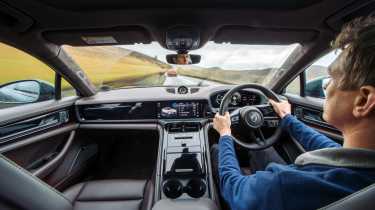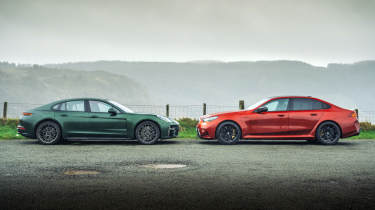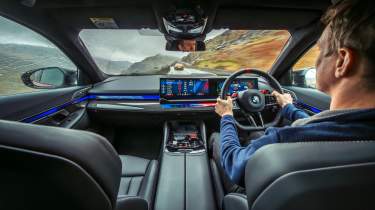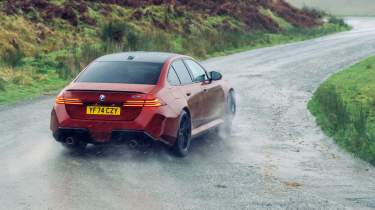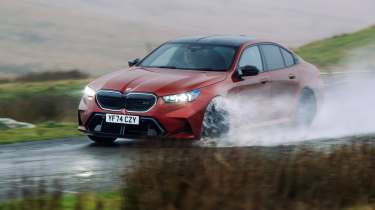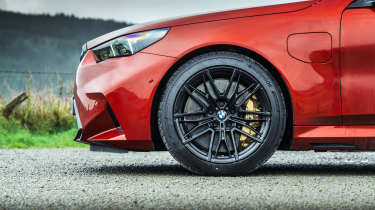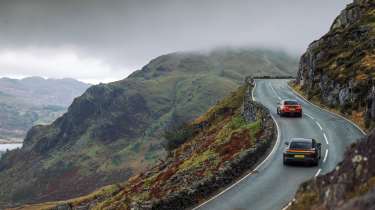BMW M5 (G90) v Porsche Panamera Turbo E‑Hybrid – 700bhp hybrid super saloons go head-to-head
BMW’s M5 has entered its hybrid era and now faces a new breed of rivals. How does it compare with another tech-packed German, Porsche’s Panamera Turbo E‑Hybrid?
England is heavily cloaked in darkness when I leave my home at early-o’clock on the test’s first morning. Thick darkness, apart from streetlights reflecting a twinkle of frost on the ground. The Panamera Turbo E‑Hybrid is waiting on the driveway. Windscreens on adjacent cars are coated with ice but the Porsche’s is clear: in a rare fit of organisation, I programmed the departure time into the car’s pre-heating menu last night. The cabin’s already warm when I climb aboard. I slink away in electrically powered silence without waking the neighbours, the wide Michelins squirming a little on the chilly ground, a north Wales postcode in the nav system, a full tank and no need to stop for fuel – or to charge the battery – before I get there. Hybrid motoring has some advantages.
The performance hybrid is the powertrain du jour. With car makers legislated into an electric future without significant customer demand for pure-electric performance cars, plug-in hybrids with a meaningful range, hefty performance (in more ways than one; this twin test has a combined kerb weight of 4795kg) and a strong element of combustion character are becoming the norm in the high-end luxury performance car world. We’re heading for Wales to meet the new BMW M5 – which itself is now an ultra-high-performance hybrid. If the previous, F90-generation M5 going all-wheel drive was controversial back in 2017, this all-new G90 is an even bigger deal for M afficionados to acclimatise to.
> Audi RS7 v BMW M5 – pure V8 battles heavy hybrid
The Porsche is an interesting counterpoint: a hybrid option has been established in the Panamera range since 2011. As with the BMW, the latest Panamera hybrid combines a twin-turbo V8 with an electric motor integrated into the transmission. The Porsche’s 4-litre engine is shared with various high-end models in the VW Group empire, including the latest Bentley Continental GT, which uses elements of the Panam’s platform and hybrid system.
The Porsche defaults to electric ‘E‑Power’ mode on start-up, switching to Hybrid Auto mode once its range is depleted, or when the driver turns the little clickwheel at the bottom right of the steering wheel. It can travel at up to 87mph without waking the V8 (as too can the M5). Although on-paper WLTP electric range is 46-57 miles, meaning you’ll pay eight per cent Benefit in Kind company car tax until the end of 2025, climbing by one per cent each year through to the end of 2028, in this cold weather (around 1.5deg C, according to the dashboard) it depletes its battery far quicker than that: in the two miles or so it takes me to get from my driveway, through town, to the A1 in electric mode, the battery charge drops from an indicated 93 per cent to 80.
I twist the drive mode switch and the V8 comes to life with a muted whumph. It’s so smooth it’s almost hard to detect it chiming in. Which is very much in line with the Panamera’s ethos: it is a limo, after all. In Hybrid Auto mode, and with the suspension set to its softest setting, it wafts along the road rather than mainlines you into it as a 911 would.
That sensation is amplified by this car’s Active Ride Control, a £6978 option. Every new Panamera, hybrid or otherwise, rides on adaptively damped air suspension. Hybrid versions’ 400V architecture enables the active option, with single-chamber, two-valve dampers connected to hydraulic pumps, each damper operating independently. The system has the capability to keep the car almost entirely flat while cornering or dealing with bumps; the standard car’s rear anti-roll bars are deleted and the set-up could, in certain circumstances, ‘overcompensate’ for weight transfer and carve into corners like a motorcycle or rise at the rear to counteract squat under acceleration.
Realising this would feel a little disconcerting for many drivers, Porsche has deliberately engineered a little roll and pitch into the Panam’s movements (particularly in Sport and Sport Plus modes, when you’re likely to be driving with more brio), and it feels, mostly, natural. The system is at its most roll-resistant in Comfort mode, and initially it feels a little uncanny through roundabouts and tight corners. The reduction of body roll makes you realise how much you normally depend on it to understand when and how a car is reaching its limits of grip. But once you’ve tuned into the system’s behaviour, you begin to relish the Panamera’s smooth stability, and it still telegraphs its limits well. It still drives like a limo with the soul of a sports car.
Performance is potent, too. The Panamera is so smooth and relaxing generally that it’s not until I accelerate smartly out of a junction and my head hits the headrest that it makes its full 671bhp/686lb ft muscle known. It’s the full proverbial scalded cat, and the V8, previously whisper-quiet, emits a disgruntled growl like a scalded tiger. (This Turbo E‑Hybrid isn’t even the fastest Panamera: there’s a £23k-pricier Turbo S E‑Hybrid with 771bhp, 738lb ft and a 2.9sec 0-62mph time.) In Sport and Sport Plus modes the engine becomes much more vocal – partly through valves in the exhaust, partly through artificially enhanced sound in the cabin (which is a little odd and synthetic-sounding).
The steering too becomes keener in Sport and Sport Plus. It’s hard to get into a rhythm in full-alert Sport Plus; the firmest suspension mode is best reserved for very smooth tarmac and middling Sport feels the best mix for these give-and-take roads as we cross the border and forge further into Wales. You can mix and match drive mode with damping level, however, with a few prods on the touchscreen. There’s also a gimme-all-you-got Sport Response switch, which locks in the most aggressive engine and transmission map for 20 seconds to assist with an overtake or boost out of a hairpin – just as the M5 has a Boost mode accessed by holding the left-hand gearchange paddle.
Not that the Porsche ever feels sluggish. With plenty of rubber on the ground and all-wheel drive, the Panamera never struggles for traction (though the wide tyres do aquaplane a little at times as the pouring rain intensifies). In cornering, its limits are extraordinarily high, even with the traction control disabled (wholly, or partially, via Sport mode). You have to be pushing quite hard for it to do something untoward, at which point – due in no small part to the 2360kg kerb weight – you’re carrying a considerable amount of momentum. Its feedback might not be as crystal-clear as that of some more traditional sports saloons but the overall sense is of a fundamentally well-sorted car. The wafty limo quality is ever-present at low speeds but, out here in the Welsh wilderness, the Panamera feels poised, controlled and keen.
After hours of A-road drudgery, the last few miles melt away in an enjoyable rhythm and all of a sudden I’m at our meeting point, where photographer Aston Parrott is waiting in the Fast Fleet Octavia vRS estate. That’s not a small car but it looks it next to the Panamera. (I spent a few days with the Porsche prior to this test, and at one point ended up missing a train as I couldn’t find a big enough parking space in the station car park.) Then staff writer Sam Jenkins approaches in the M5, and Aston and I both burst out laughing – because the BMW is so vast that it dwarfs the Panamera. At 5.1m long and 1.5m tall, the M5 makes the Porsche look like a toy car. And the M5’s wheels (21-inch at the front and 22 rear) look like castors next to its deep-sided, high-roofed body. It’s enormous.
‘It doesn’t feel it though,’ Sam says. ‘Driving it, you’d swear it’s about two thirds the size it really is…’ Let’s find out. Climb aboard and you find yourself in a slightly garish cabin compared with the clean, minimal Porsche. Slightly garish compared with most cars, in fact. The dash and doors are dominated by strips of ambient lighting, with endless switchable colour options including radiant coral, papaya and salmon (and a few less bold ones). Giant IMAX-style curved screens sit on top of the dash, powered by the latest generation of BMW’s iDrive system and its slightly-fiddlier-than-it-used-to-be combined touchscreen and clickwheel interface. The plumply bolstered seats feel like armchairs after the Panamera’s slimmer sports seats. And you feel like you’re sitting in the sky: whereas the Porsche can offer a truly low-slung, sports-car driving position, the M5’s seats don’t sink particularly low. Partly to blame is the 220kg battery pack, packaged around the transmission tunnel, and its attendant under-body bracing. Mind you, there’s a lot of screen display you need to be able to peer over…
With the busy interior, chunky seats and crossoverish driving position, the impression before you set off is that the M5 is going to be a complex, cumbersome object to drive. The reality is different. The steering is the first surprise. It responds instantly – no slack. Precisely, too. It’s fast but not nervous. As with most modern M cars, there’s buckets of front-end grip (even while it’s bucketing with rain), and the rear follows smartly too. It’s a very positive car.
That includes the brakes: in contrast with the Panamera’s pedal, which has something of a soft zone you must push through before the brakes bite reassuringly, the BMW has alert stopping power from the get-go. You can select from two settings in the drive mode menus, Comfort or Sport, the latter with a more responsive initial contact from the pedal.
This M5 is on carbon-ceramic brakes, an £8850 option (fitted here as part of the eye-watering £19,500 Ultimate Pack, which bundles carbon exterior trim alongside various other options), while the Porsche is on its standard cast-iron discs. On which, there is a fairly chunky price differential between these two. The Panamera Turbo E‑Hybrid costs £145,400 before options to the M5’s £111,405. This heavily optioned Panamera weighs in at nearly £190k, and the BMW more than £130k.
It won’t have escaped your attention that there is now an M5 Touring too, which costs an additional £2000. Porsche chose to retire the Panamera Sport Turismo for this 2024-on generation due to lack of demand, although insiders say it was a close-run decision. Let’s see how sales play out for BMW.
Meanwhile, behind the wheel, the surprises keep coming. Sam is right: the way the M5 gets into and through a corner, it really does feel like a much smaller car. You’d swear it weighs about 800kg less than it does. The official kerb weight is 2435kg, more than 500kg heavier than the previous M5. The Panamera’s official weight isn’t much lighter either, at 2360kg in this trim.
As well as the M5’s variable-ratio steering at the front, the rear wheels being actively steered too plays a part. This is the second M car to have rear-steer after the XM (which shares the same PHEV powertrain) and it works well, helping to pivot the big BMW into tight corners and virtually extending its – already enormous – wheelbase at speed for stability. The Porsche is fitted with all-wheel steering too, as a £1541 option. You can see it in action on both cars when they’re manoeuvring at parking speeds. The BMW’s system is subtle in operation; you sense that something is helping this big bus turn with ballerina-like alacrity, but it doesn’t feel totally unnatural.
Damping in the M5 is not as smooth as in the Porsche – it’s on conventional adaptive dampers and non-air springs, after all. When we swap cars once more, I follow in the Porsche and can see the M5 taking small body-blows from bumps while the Panamera glides over them. But the BMW’s ride and body control are excellent considering the mass at play. There are times when it can’t disguise that totally, with the occasional nasty thump through the chassis, particularly if you encounter a bump mid-corner with the car loaded up. But the facade doesn’t slip often.
Both cars are seriously quick. Subjectively, the BMW feels faster, although not as fast as 717bhp and 737lb ft sounds on paper. That elephantine mass means its power-to-weight ratio is actually slightly down on the old M5’s. Then again, you could never describe it as ‘slow’. With the electric motor and 4.4-litre twin-turbocharged V8 engine working together, this is a missile of a car.
The M5 has a claimed electric driving range of 37-42 miles and enjoys the same BIK tax benefits as the Porsche. Also as with the Porsche, the hybrid powertrain’s baton-pass between e-motor and engine, or the transition into both power units working together, is seamlessly smooth. Both cars have a raft of operating modes: in addition to regular hybrid running, the Panamera allows you to select an E‑Charge function to top the battery up via the engine (something it also does in its sportier driving modes), and E‑Hold, to save the existing battery charge for later – if you’re heading to a city, for example. Similarly, the M5 offers Dynamic (balanced power for longer journeys), Dynamic Plus (maximum power for shorter distances), Hybrid (focused on range) and the pure Electric mode.
This being a modern M car, there are endless modes for the dynamics too. Steering, damping, gearchange map, energy recovery, powertrain map… As with the M3 and M4, it’s almost overwhelming. The ‘M1’ and ‘M2’ quick-flick buttons on the wheel to short-cut to favourite settings are essential. As with other modern-day M cars, the M5 can also switch between 4WD, a more rear-biased 4WD Sport mode and a pure rear-drive mode (though it doesn’t have the handy variable traction control of some of its stablemates). In regular 4WD mode it’s already relatively rear-biased, but out of slow corners in these sodden conditions you can feel it claw its way forward with the front axle engaged. In 4WD Sport it’s really quite playful, keener to dance than the four-square-stance Panamera. Both cars are very grippy but the Porsche needs more provocation to move around.
In the pouring rain, this M5’s Hankook tyres find plenty of purchase (though they’ll later push into understeer a little more readily in dryer but greasier conditions). They’re slightly wider at the front but much narrower than the Panamera’s at the rear, at 295mm versus 325mm. Perhaps that contributes to the M5’s more eager feel generally, as does its more ‘normal’ suspension to a more natural feel on the limit. Both cars have a long wheelbase but the BMW’s 3m gap between the axles is longer than an entire Toyota iQ. That helps its predictability in an oversteer situation, and this blend of predictable yet wieldy nimbleness makes it a surprisingly rounded performance car.
More rounded than previous-generation M5s? Certainly this is a car with greater bandwidth than before, and in the right circumstances more efficiency too; both cars return average mpg in the mid-20s over the course of our two-day, two-country test, with plenty of A- and B-road miles in mixed conditions and at mixed speeds. But despite its surprising agility, the new M5’s size, weight and complexity make it – for me, at least – a difficult car to fall for wholeheartedly. I’m not sure I wouldn’t have just as much fun in the previous, non-hybrid M5 on these roads. Maybe more. And I certainly would in the (admittedly exceptional) M5 CS.
I am having more fun in the new M5 than in the Porsche, however. Which is not to say that the Panamera is a poor driving experience. There’s a lot about the way it goes about its business that to some tastes might make it the more desirable car: it’s more grown-up, more polished in feel, all about making speed and distance effortlessly. While the M5 is the keener-feeling car, there’s an appeal in the Panamera’s more measured, linear steering and overall dynamic character. And the way its interior is drawn – a clean, minimal (perhaps too minimal; clinical almost) environment – is a calming contrast to the BMW’s busy gaucheness. Its lower driving position is a plus, too.
This has been a true long-distance test, across England to north Wales, down into mid-Wales and back across into southern England. The Panamera has proven itself to be just as excellent a grand tourer as ever. It’s a calming car, one that can play the role of GT, sports saloon and limo adroitly. The BMW, too, can still play the role of a big exec saloon very well. The suspension is (mostly) supple, the steering just calm enough, and refinement is excellent in terms of both the smooth powertrain and lack of road and engine noise. It’s quieter than the Porsche, in fact. You could argue that the BMW’s V8 could do with a bit more noise: its power delivery is silky but it doesn’t sound particularly memorable. For once, you might actually choose to switch the enhanced M Sound setting on.
Even after many hundreds of miles, it feels like a car we’re still getting to know. It’s a more complex kind of M5. A compelling one, but whether it’s as compelling as M5s of old is another question. I respect the Porsche more than I desire it – and although the M5 is the more thrilling drive, I feel the same way about the BMW too. But going hybrid has given it a broader range of talents, and if it means the M5 can stick around as we know it for a while longer, it’s something to be saluted.
Since Mercedes-AMG currently doesn’t make an E63, and couldn’t (or wouldn’t) make a C63 available for a comparison test, that makes the new M5 our current king of the high-tech German hybrids.
Specs
| BMW M5 | Porsche Panamera Turbo E-Hybrid | |
| Engine | V8, 4395cc, twin-turbo, plus 145kW e-motor | V8, 3996cc, twin-turbo, plus 140kW e-motor |
| Combined power | 717bhp | 671bhp |
| Torque | 737lb ft | 686lb ft |
| Weight | 2435kg | 2360kg |
| Power-to-weight | 299bhp/ton | 289bhp/ton |
| Tyres as tested | Hankook Ventus S1 evo Z | Michelin Pilot Sport S 5 |
| 0-62mph | 3.5sec | 3.2sec |
| Top speed | 190mph (with M Driver’s Package) | 196mph |
| Basic price | £111,405 (£131,950 as tested) | £145,400 (£188,262 as tested) |
This story first featured in evo issue 330.
